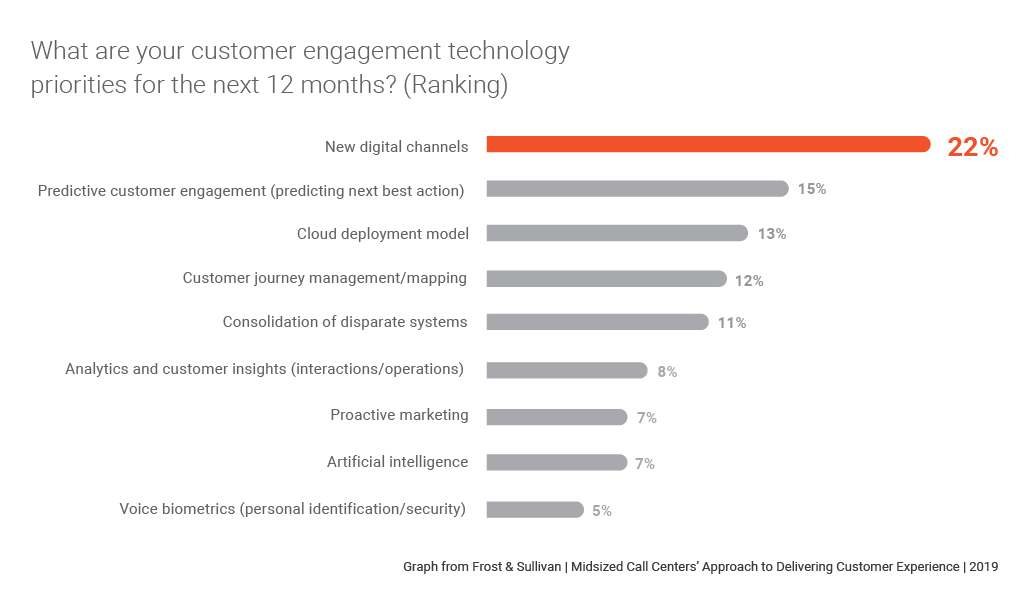Your Genesys Blog Subscription has been confirmed!
Please add genesys@email.genesys.com to your safe sender list to ensure you receive the weekly blog notifications.
Subscribe to our free newsletter and get blog updates in your inbox
Don't Show This Again.

“The realm of customer contact is an exciting place to be. No longer a cost center, but the hub of exceptional CX and engagement, the contact center is the modern focal point for competitive differentiation.” – Frost & Sullivan, Global Research Midsized Call Centers take a Digital-first Approach
For its new report, Frost & Sullivan surveyed 600 business and IT decision makers from around the world. It aimed to understand how they use technology to meet rising customer experience expectations and which technology trends are key to meet emerging customer expectations.

1. New digital channels
Making sure that your business is available on a customer’s preferred digital channel is key. So, many call centers prioritize digital growth — and plan to keep it a priority as they move toward 2020 and beyond.
2. Predictive customer engagement
You know a lot about your customers; use that knowledge. Train your agents so they can guide customer journeys. It’s important to leverage historical data to anticipate the next best action for individual customers.
3. Cloud deployment model
There’s a reason why cloud deployment is a long-standing technology trend. The cloud gives your call center flexibility and scalability. As mid-sized call centers work to match larger competitors, a cloud-based solution lets them adjust, on the fly, to meet business needs.
4. Customer journey management/mapping
A lot of tech trends revolve around using your data to drive the customer experience. For the customer journey, analyze that data and use the results to map out common situations.
5. Consolidation of disparate systems
Siloed technology slows business operations and makes interactions difficult for agents and customers. Moving your call center to an all-in-one system will save you time and money in the long run.
6. Analytics and customer insights
Data is king; and modern technology let’s your call center analyze and draw insights from that. Mine prior customer input and use what you learn to improve things for current customers.
7. Proactive marketing
Much like predictive engagement, proactive marketing means using what you know about your customers to decide what information they need. Being proactive — as opposed to reactive — requires agile technology. Use that technology to adapt with your customers. Feed your agents real-time info on customer desires so that they’re ready to meet expectations.
8. Artificial intelligence (AI)
While it’s not directly stated, many of the trends listed here have roots in AI. AI takes the data you’ve collected, analyzes it and finds trends within it to give you useful insights. But AI can also help handle call volume. Bots are becoming more common in the call center and customer service industries. A well-programmed bot can help customers answer common questions — freeing up your agents to handle more complex issues.
9. Voice biometrics
Voice biometrics — also called voice recognition or voice authentication — simplifies security for call center customers by making their voice a password. And that security is ensured in omnichannel journeys — even if a customer calls from a new phone number.
Focus on the customer experience
Technology, if used properly, is a great tool to improve the customer experience. Learn more about what’s driving customer service in the call center by downloading the report from Frost & Sullivan.
Subscribe to our free newsletter and get blog updates in your inbox.